The world of birds is a world of extremes. From flightless giants like the Common Ostrich (the largest bird in the world) to flying heavyweights like the Great Bustard to flashy icons like the Peacock, there is no shortage of interesting and diverse features amongst the birds of the world. But while big birds might be hard to miss, the tiniest birds in the world are no less fascinating. Let’s say hello to seven of the smallest birds in the world including the record-holder for the world’s smallest bird.
#1: The Smallest Bird in the World — The Bee Hummingbird
If you know even a little bit about birds, then it should come as no surprise that the smallest member of the avian class is also a member of the hummingbird family. Hummingbirds are the 366 members of the Trochilidae family. They are known for being tiny, for sipping on nectar, and for their specialized wing joints that allow their wings to beat in full circles– backward and forward, allowing them to hover. No other family of birds is able to fly this way!
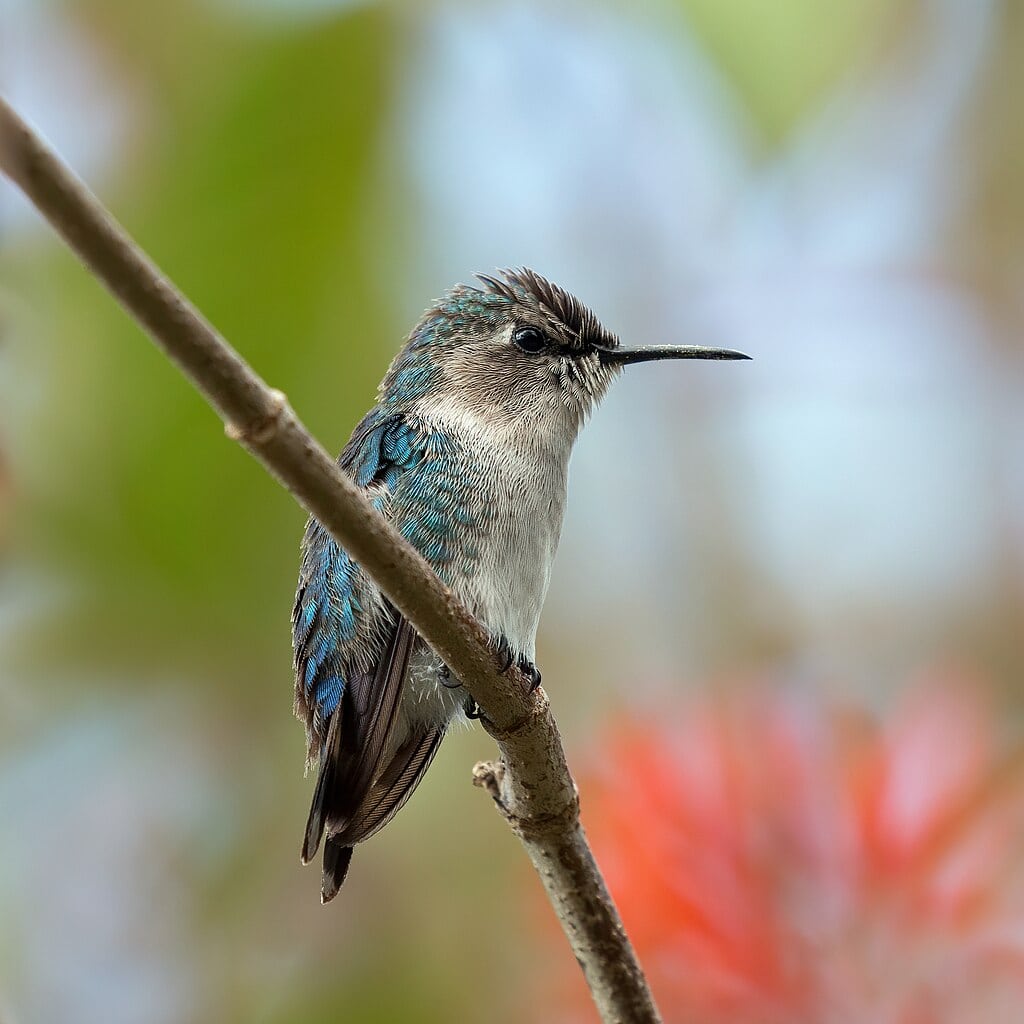
It’s hard to visualize just from photographs how much smaller hummingbirds are than most other birds. So, like always, I recommend getting out there and doing some birding. Set up a hummingbird feeder and watch as the tiny sparrows that used to be the “little guys” of your backyard setup now seem to totally dwarf your hummingbird visitors. If you need a hand getting started, our guide for attracting hummingbirds can help.
But unless you live in Cuba, the hummingbirds in your backyard are still quite large compared to the Bee Hummingbird. Accurately named, the Bee Hummingbird is the smallest bird in the world— a half-pint even amongst the other members of the tiny Trochilidae family.
Quick Facts About the Bee Hummingbird:
- The Bee Hummingbird’s scientific name is Mellisuga helenae. It belongs to a genus of the Trochilidae family. The Mellisuga genus are also referred to as the “Bee Hummingbirds,” so you know this little guy belongs there! Mellisuga is also home to the second smallest bird in the world: Mellisuga minima, the Vervain Hummingbird.
- The Bee Hummingbird measures between 5.5 and 6.1 centimeters depending on the size and sex of the individual. The females tend to be slightly larger (although it would be a mistake to think of them as “large”).
- An adult male Bee Hummingbird weighs as little as 1.9 grams. That’s less than the weight of a single US dime.
- Have you ever asked yourself “What does the smallest bird in the world eat?” Ask no more! The Bee Hummingbird isn’t just the size of a bee. It’s also a fan of the same nectar that bees collect. Bee Hummingbirds enjoy the nectar of ten specific native flowers in Cuba, including the aptly named “hummingbird bush.” But that’s not all. Bee Hummingbirds will sometimes eat insects too. It pays to be an opportunist when every calorie counts. Despite their petite builds, Bee Hummingbirds have to consume up to half their body weight every day to maintain their fast metabolism and keep up with their sky-high energy expenditure.
- The smallest birds lay the smallest eggs! Bee Hummingbird eggs are about the size of a coffee bean and usually weigh less than half the weight of your average sewing needle. They are the smallest eggs of all birds.
#2: The Second Smallest Bird in the World — The Vervain Hummingbird
Next up on our list is another “Bee Hummingbird.” These little guys have cornered the market on being small! The Vervain Hummingbird belongs to the same genus as the Bee Hummingbird, but instead of dwelling in Cuba, they’re found in Jamaica with a nominal subspecies that’s also found in the Dominican Republic, Haiti, and the surrounding islands.
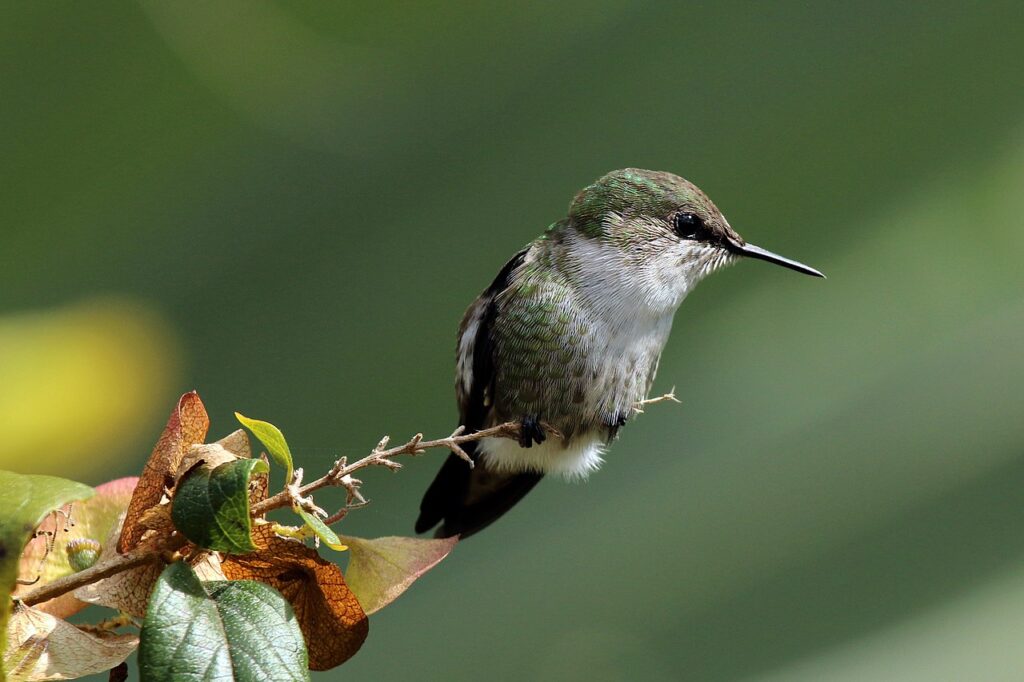
There isn’t a lot to say about the Vervain Hummingbird that isn’t already covered by its more famous cousin, but let’s look at some quick facts anyhow.
Quick Facts About the Vervain Hummingbird:
- The Vervain Hummingbird is about 6 centimeters long and typically weighs in between 2 and 2.4 grams. That might not be smaller than a dime (they weigh just under 2.3 grams) but at its largest the Vervain Hummingbird still weighs less than a US penny (2.5 grams).
- A Vervain Hummingbird’s eggs are likely the second smallest too! They can measure as little as 1 centimeter in length and weigh in at around .38 grams. For reference, your run-of-the-mill paperclip weighs 1 whole gram. They may not be the smallest but that’s still pretty tiny!
#3 The Smallest Bird in Australia — The Weebill
Here is where it gets complicated. You see, there are no formal scientific rankings for the “biggest” or “smallest” birds. The Bee Hummingbird is known to be the smallest by all measures and the Vervain Hummingbird is believed to be the second smallest, but after that we have to look at things like wingspan and weight. Some birds have a lot of variation between sexes as well. So rankings become tricky.
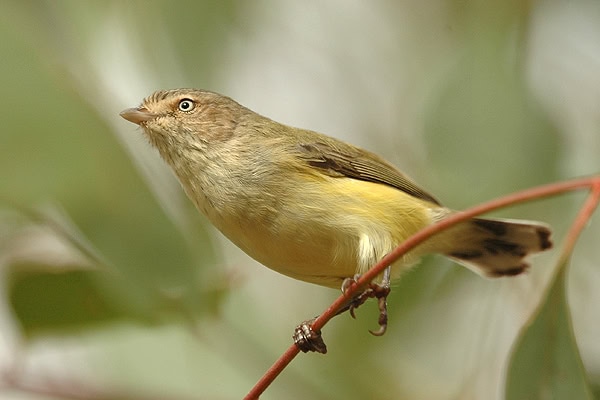
For this article, I want to introduce you to some unique tiny birds. This means saying goodbye to the Trochilidae family. Hummingbirds dominate the rankings and this list could easily go through five more hummingbirds before we ever discuss anything over 4 centimeters. So, let’s look at some small birds outside of this family.
And what better place to start than Australia! Australia doesn’t have hummingbirds, so its smallest bird is quite a bit larger than Cuba’s Bee Hummingbird. The smallest bird in Australia is the Weebill (Smicrornis brevirostris). Weebills belong to a family sometimes referred to as the “Australian Warblers.”
Quick Facts About the Weebill:
- The Australian Warbler family (Acanthizidae) are mostly terrestrial, meaning that they tend to forage on the ground. The Weebill is not just an outlier for its size. Its lifestyle is also unique. Weebills make their living foraging in treetops.
- The Weebill is named for its wee bill. No, really! Weebills have noticeably short and stubby bills that stand out from other Australian Warblers.
- The Weebill may be “wee,” but it’s much larger than our Bee Hummingbirds from earlier. The Weebill measures in at between 8 and 9 centimeters in length and weighs about 6 grams on average. That’s more than three times the weight of a male Bee Hummingbird!
#4 The Smallest American Songbird — The Golden-crowned Kinglet
Now that we’ve left hummingbirds behind us, let’s discuss some of the tiniest songbirds you might have seen in your own backyard. there are two major families to contend with for this category: kinglets and tits. Both families are miniscule, with the Golden-crowned Kinglet (Regulus satrapa), the Ruby-crowned Kinglet (Corthylio calendula), and the American Bushtit (Psaltriparus minimus) all weighing in at very similar lengths and weights. Crowning one as the definitive winner for North America’s smallest backyard songbird or “passerine,” is a tough question.
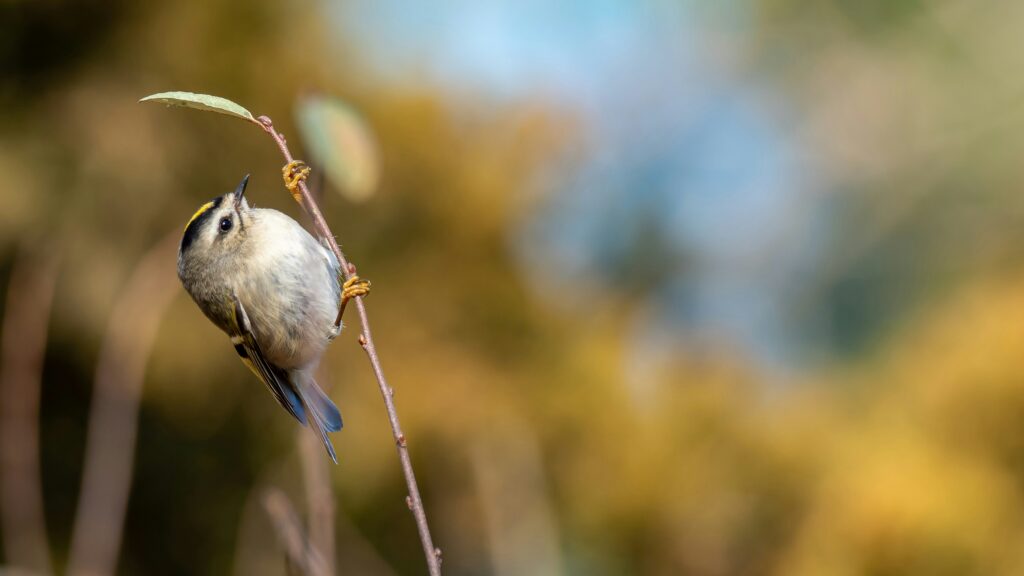
For our purposes, I’ve decided to hone in on the Golden-crowned Kinglet. This is a nearly arbitrary choice since the length and weight ranges for all three of these species overlap significantly, but as far as I can tell the Golden-crowned Kinglet tends to be the smallest of the three.
Quick Facts About the Golden-crowned Kinglet:
- The Golden-crowned Kinglet ranges from eight to eleven centimeters in length with a wingspan of 14 to 18 centimeters. These tiny songbirds can weigh anywhere from 4.5 to 7.8 grams.
- Ruby-crowned Kinglets and Golden-crowned Kinglets aren’t just alike in size. They have a lot more in common! So much, in fact, that they may be capable of hybridization. A Ruby-crowned Kinglet and Golden-crowned Kinglet hybrid is one theory used to explain the mysterious “Cuvier’s Kinglet,” a seemingly nonexistent bird painted by John James Audubon in 1812. Even amongst the most common backyard birds, there are still new discoveries to be made!
- Tiny but mighty, the Golden-crowned Kinglet is capable of withstanding harsh winters despite its itty bitty frame. Golden-crowned Kinglets are regularly found spending the winter in regions where temperatures drop below -40 degrees Fahrenheit.
#5 The Smallest Bird of Prey — The Falconet
Once again, we have to choose between two similarly-sized birds to contend for the category of the world’s smallest bird of prey. Both members of the Asian Falconet genus Microhierax, the Black-thighed Falconet (Microhierax fringillarius) and the White-fronted Falconet (Microhierax latifrons) are so small that you might mistake them for sparrows. Both species are found in Southeast Asia and are adapted for insect-eating.
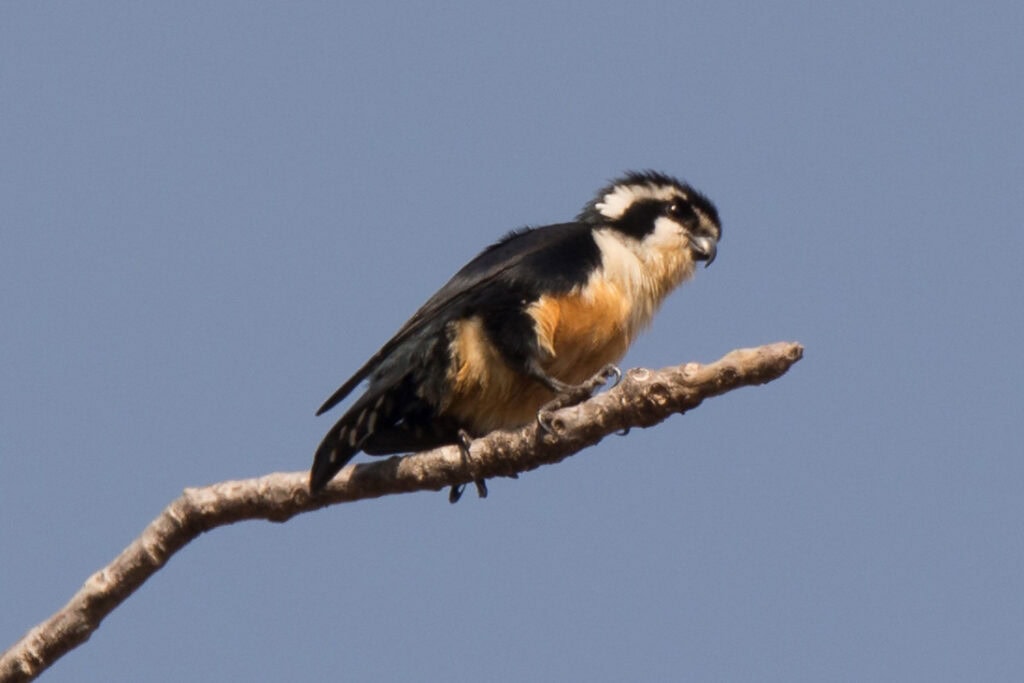
While we chose to focus on the Golden-crowned Kinglet in the last section, these two Asian Falconets are so similar that we’ll have to award the title of the world’s smallest raptor to both of them. In fact, that’s precisely how the Guinness Book of World Records has handled this title.
Quick Facts About the Black-thighed Falconet and the White-fronted Falconet:
- Both the Black-thighed and White-fronted Falconet range in length from around 14 to 17 centimeters. Some sources list one species as the smallest of the two, but these are inconsistent and their size ranges are so close that it’s almost impossible to name one as the smaller bird.
- There is little biographical information available on the internet regarding how these birds live. What we do know is that both species seem to be fairly social and are often found in groups. Black-thighed Falconets are even seen preening each other, suggesting stronger-than-usual social ties for a raptor species.
- Both of these tiny falconet species are known to be cavity nesters. This means that they lay their eggs in abandoned holes left behind by woodpeckers or barbets. Cavity nesters tend to be especially vulnerable to deforestation.
#6 The Smallest Owl — The Elf Owl
Now that we’ve established the smallest raptors in the world, let’s get a bit more specific. Raptors come in many different shapes and sizes, but amongst the smallest is a diminutive little owl known as the Elf Owl. The Elf Owl is the smallest owl in the world and is only marginally larger than a falconet.
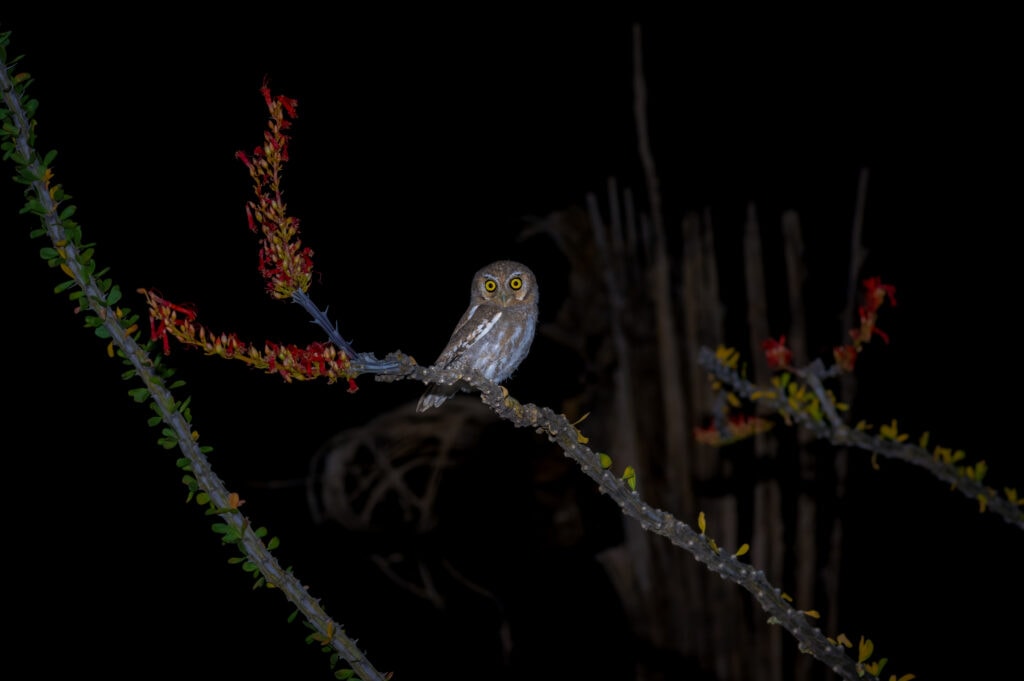
Like falconets, Elf Owls are adapted for hunting insects. Unlike our two falconets, Elf Owls are found in North America with a habitat that spans much of Mexico, including Baja California and even reaching into some of the southernmost portions of the Southwestern United States.
Quick Facts About the Elf Owl:
- The Elf Owl may actually be the smallest raptor. “What? How can that be? I thought it was our falconets?” Yes and no. Like I said before, rankings are confusing. If we measure by length, the Elf Owl is only between 12 and 14 centimeters long, a bit smaller than the falconets. I would love to explain why so many sources give this title to the two falconets from our last entry, but there is no formal reasoning available for this. What I can definitively say is that the Elf Owl is the absolute smallest of the owls.
- Elf Owls have a peculiar habit of capturing tiny threadsnakes. They don’t eat these snakes, but instead bring them back to their nests. It is believed that the threadsnakes act as pest control, eating parasites that might threaten the Elf Owl’s young.
- Elf Owls weigh between 35 and 55 grams. This may seem like a lot after reading about the Bee Hummingbird, but keep in mind that this is smaller than the weight range for your average pet mouse. Elf Owls are still total featherweights!
- Like the falconets in the previous section, Elf Owls are cavity nesters. Unlike the falconets, though, Elf Owls often live in Southwestern desert habitats and are known to use Saguaro Cacti as a home.
#7 The Smallest Shorebird — The Least Sandpiper
We’re going to round out today’s list with another bird that is positively enormous when compared to a tiny hummingbird like the Bee Hummingbird, but it is still the smallest in its category. The Least Sandpiper is similar in size to the Elf Owl. The Least Sandpiper is the smallest shorebird and the smallest of the sandpipers.
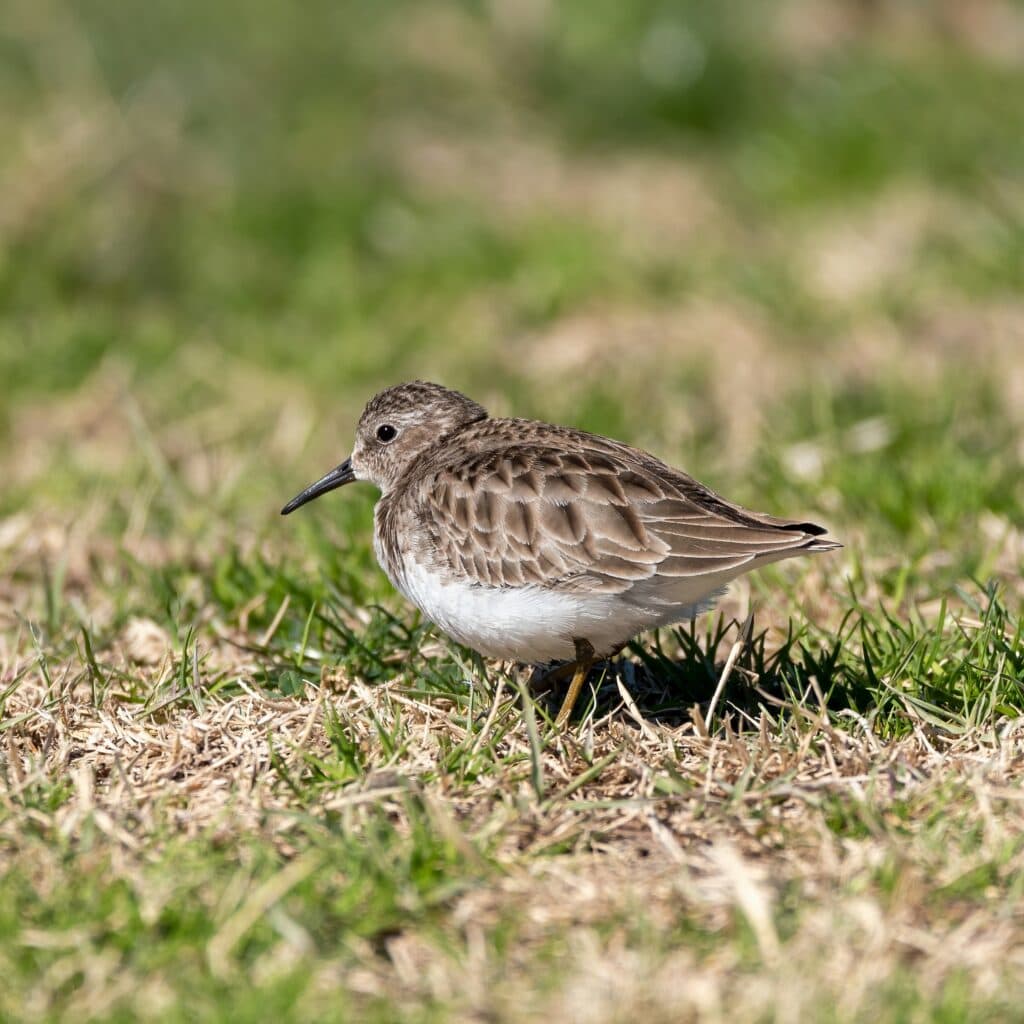
Least Sandpipers are found throughout North and Central America as well as sections of South America. They migrate from the northern portions of South America where they spend their winters all the way to the northernmost regions of Canada where they breed. This far-reaching migration can span up to 2,500 miles— quite a journey for such a small bird!
Quick Facts About the Least Sandpiper:
- Least Sandpipers range in length from 13 to 15 centimeters and can weigh as little as 19 to 30 grams. That’s between 0.7 and 1.1 ounces– less than a standard-sized pencil at their smallest!
- Female Least Sandpipers tend to have longer bills than their male counterparts, enabling them to forage deeper in the mud for the arthropods that make up the majority of the Least Sandpiper’s diet.
- Least Sandpipers are monogamous– at least for the breeding season. A male and female will incubate their eggs and rear their brood together as a pair.
- Least Sandpiper chicks are what we call “precocial.” They are the only birds on this list with precocial chicks. Precocial chicks are born ready to walk, find food, and generally take care of themselves. They aren’t typically fully independent, but they can leave the nest right away. Baby ducks or chickens are a good example of this. They still need parents for a while, but they’re fuzzy and full of energy within a few hours of hatching. For altricial birds, like the others on this list, babies are helpless and can’t leave their nests for weeks or even months. There are costs and benefits to each strategy, but the Least Sandpiper must be precocial because these birds nest in scrapes in the ground. Their young would be extremely vulnerable to predation if they were unable to leave the nest quickly.
Final Thoughts
The smallest birds in the world may be tiny, but good things do come in small packages! I hope this list has been helpful for you and has inspired a love for these extreme members of the world of birds. Feel free to comment below with questions, suggestions, or feedback. Happy birding!

